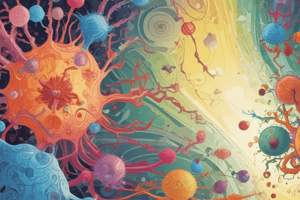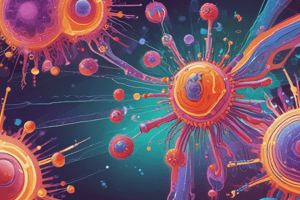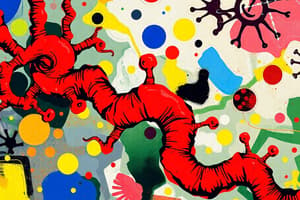Podcast
Questions and Answers
Which of the following is the primary function of antibodies produced by B lymphocytes?
Which of the following is the primary function of antibodies produced by B lymphocytes?
- Directly destroying infected cells through lysis.
- Activating cytotoxic T cells to kill infected cells.
- Neutralizing microorganisms and marking them for destruction by phagocytes or complement. (correct)
- Enhancing the inflammatory response at the site of infection.
How do helper T cells (CD4+) contribute to antibody-mediated immunity?
How do helper T cells (CD4+) contribute to antibody-mediated immunity?
- They suppress the activation of B cells to prevent autoimmune reactions.
- They directly kill antibody-producing plasma cells to regulate antibody levels.
- They secrete cytokines that help activate B cells to differentiate into plasma cells and memory cells. (correct)
- They produce antibodies with broad specificity.
Which of the following statements correctly differentiates between antibody-mediated and cell-mediated immunity?
Which of the following statements correctly differentiates between antibody-mediated and cell-mediated immunity?
- Antibody-mediated immunity is activated by cancerous cells, while cell-mediated immunity is activated by viral infections.
- Antibody-mediated immunity targets intracellular pathogens, while cell-mediated immunity targets extracellular pathogens.
- Antibody-mediated immunity is responsible for immunological memory, while cell-mediated immunity provides immediate protection.
- Antibody-mediated immunity involves B lymphocytes and antibody production, while cell-mediated immunity involves T lymphocytes and direct cell destruction or cytokine release. (correct)
What is the role of memory B cells in the adaptive immune response?
What is the role of memory B cells in the adaptive immune response?
Cytotoxic T cells (CD8+) and antibodies both contribute to the adaptive immune response. What is a key difference in their mechanisms of action?
Cytotoxic T cells (CD8+) and antibodies both contribute to the adaptive immune response. What is a key difference in their mechanisms of action?
What is the primary role of plasma cells in humoral immunity?
What is the primary role of plasma cells in humoral immunity?
Which of the following events initiates the primary immune response mediated by B lymphocytes?
Which of the following events initiates the primary immune response mediated by B lymphocytes?
What is the function of memory B cells during a secondary encounter with an antigen?
What is the function of memory B cells during a secondary encounter with an antigen?
How does the secondary immune response differ from the primary immune response?
How does the secondary immune response differ from the primary immune response?
Which of the following best describes the clonal selection process in B lymphocytes?
Which of the following best describes the clonal selection process in B lymphocytes?
In humoral immunity, what directly results from the proliferation of an activated B cell?
In humoral immunity, what directly results from the proliferation of an activated B cell?
An individual is exposed to a weakened form of a virus, resulting in the production of antibodies and memory cells. This is an example of what?
An individual is exposed to a weakened form of a virus, resulting in the production of antibodies and memory cells. This is an example of what?
If a patient lacks memory B cells, what immune response would be most affected?
If a patient lacks memory B cells, what immune response would be most affected?
Which of the following is the primary role of antibodies in humoral immunity?
Which of the following is the primary role of antibodies in humoral immunity?
What is the relationship between B cells and plasma cells in the context of antibody production?
What is the relationship between B cells and plasma cells in the context of antibody production?
How do antibodies contribute to the activation of the complement system?
How do antibodies contribute to the activation of the complement system?
Which of the following is NOT a typical function of antibodies?
Which of the following is NOT a typical function of antibodies?
What is the role of memory B cells in adaptive immunity?
What is the role of memory B cells in adaptive immunity?
Considering the adaptive immune response, what triggers the activation of naive B cells?
Considering the adaptive immune response, what triggers the activation of naive B cells?
If a person lacks helper T cells, how would this affect the humoral immune response?
If a person lacks helper T cells, how would this affect the humoral immune response?
Which process describes how antibodies prevent a virus from infecting a host cell?
Which process describes how antibodies prevent a virus from infecting a host cell?
How does antibody-dependent cell-mediated cytotoxicity (ADCC) function?
How does antibody-dependent cell-mediated cytotoxicity (ADCC) function?
What is the outcome of injecting someone with antibodies produced by another individual?
What is the outcome of injecting someone with antibodies produced by another individual?
Which of the following events is most directly facilitated by the binding of antibodies to antigens?
Which of the following events is most directly facilitated by the binding of antibodies to antigens?
What would be the most likely result of a genetic defect that prevents the production of IgA antibodies?
What would be the most likely result of a genetic defect that prevents the production of IgA antibodies?
How do vaccines ultimately lead to long-term protection against specific pathogens?
How do vaccines ultimately lead to long-term protection against specific pathogens?
In the context of antibody structure, what part of the antibody determines its specific antigen-binding capability?
In the context of antibody structure, what part of the antibody determines its specific antigen-binding capability?
Which of the following is a key difference between the roles of antibodies and cytotoxic T cells in adaptive immunity?
Which of the following is a key difference between the roles of antibodies and cytotoxic T cells in adaptive immunity?
Flashcards
Humoral immunity
Humoral immunity
A type of immunity mediated by antibodies produced by B cells.
Primary response
Primary response
The initial immune response to an antigen upon first exposure.
Activated B cells
Activated B cells
B cells that have encountered an antigen and are now ready to proliferate.
Clonal selection
Clonal selection
Signup and view all the flashcards
Plasma cells
Plasma cells
Signup and view all the flashcards
Memory B cells
Memory B cells
Signup and view all the flashcards
Secondary response
Secondary response
Signup and view all the flashcards
Antibody secretion
Antibody secretion
Signup and view all the flashcards
B Lymphocytes
B Lymphocytes
Signup and view all the flashcards
T Lymphocytes
T Lymphocytes
Signup and view all the flashcards
Helper T Cells
Helper T Cells
Signup and view all the flashcards
Cytotoxic T Cells
Cytotoxic T Cells
Signup and view all the flashcards
Acquired Immunity
Acquired Immunity
Signup and view all the flashcards
Cellular immunity
Cellular immunity
Signup and view all the flashcards
Antigen (Ag)
Antigen (Ag)
Signup and view all the flashcards
Adaptive defenses
Adaptive defenses
Signup and view all the flashcards
Innate defenses
Innate defenses
Signup and view all the flashcards
Ag-presenting cells (APCs)
Ag-presenting cells (APCs)
Signup and view all the flashcards
Naive T cells
Naive T cells
Signup and view all the flashcards
Cytokines
Cytokines
Signup and view all the flashcards
Nonspecific killers
Nonspecific killers
Signup and view all the flashcards
Antibodies (Igs)
Antibodies (Igs)
Signup and view all the flashcards
Study Notes
Adaptive/Specific Immunity
- Adaptive immunity is a specific immune response to antigens
- Objectives include defining antigens, explaining how T and B cells arise and their roles, defining antibodies and their function, defining antibody-mediated (humoral) and cell-mediated immunity, discussing primary and secondary responses to antigens, and explaining active and passive immunity acquisition (naturally and artificially).
Overview of Body Defenses
- Innate defenses include surface barriers (skin, mucous membranes) and internal defenses (phagocytes, natural killer cells, inflammation, antimicrobial proteins, fever).
- Adaptive defenses include humoral immunity (B cells) and cellular immunity (T cells).
Characteristics of Specific Defenses
- Able to identify foreign antigens (molecules)
- Antibody generating
- Specific response to destroy the foreign microbe
- This system has a memory.
Cells of the Immune Response
- Lymphocytes (B & T cells) are primary cells in the immune system, capable of recognizing and responding to specific antigens.
- They distinguish self from non-self (foreign) proteins and generate responses.
- Antigen-presenting cells include macrophages and dendritic cells.
The Immune Response (Video)
- The video provides an overview of innate and adaptive immune defenses.
- Students should read the next slide before viewing the video.
Lymphocyte Development, Maturation, and Activation
- B and T lymphocytes originate in red bone marrow.
- T cells mature in the thymus, B cells mature in bone marrow.
- Lymphocytes develop immunocompetence and self-tolerance during maturation.
- Immunocompetent but naive lymphocytes leave the thymus and bone marrow, seeding secondary lymphoid organs and circulating through blood and lymph.
- Lymphocytes become activated when encountering an antigen, proliferate, and differentiate into effector cells and memory cells. Memory cells and effector T cells continuously circulate in blood, lymph, and secondary lymphoid organs.
What are B Lymphocytes?
- B lymphocytes secrete antibodies, effective against microorganisms in extracellular fluids.
- They originate in fetal bone marrow, migrating to fetal liver and lymphoid tissues to mature.
- B cells are activated during an immune response, differentiating into plasma cells (secreting antibodies) and memory cells. They constitute 10-20% of circulating lymphocytes.
What are T Lymphocytes (T cells)?
- T lymphocytes originate in bone marrow and mature in the thymus.
- They constitute 60-70% of circulating lymphocytes, and include helper T cells (CD4+), cytotoxic T cells(CD8+), and suppressor T cells.
- Helper T cells (CD4+) secrete cytokines, regulate the immune response, and activate other T and B cells.
- Cytotoxic T cells (CD8+) kill virus-infected and cancer cells.
- Suppressor T cells dampen down responses and eliminate microorganisms living inside cells (intracellular).
Two Forms of Acquired Immunity
- Antibody-mediated immunity (humoral): involves B lymphocytes producing antibodies.
- Cell-mediated immunity: involves T lymphocytes destroying pathogens or non-self substances.
Antibody-Mediated (Humoral) Immunity
- Primary response: initial encounter with antigen triggers B cell activation and clonal proliferation
- B Cells proliferate into plasma cells and memory cells.
- Plasma cells secrete antibodies, which target the antigens.
- Memory B cells are primed to respond rapidly to the same antigen subsequently encountering it. Secondary response: More rapid and potent response on subsequent antigen exposure, due to memory cells.
Major Types of T Cells
- T cell development and maturation are explained graphically.
Simplified Summary of Primary Immune Response
- The primary response to an antigen involves the activation, proliferation, and differentiation of immune cells to eliminate the antigen, resulting in a legacy of antibodies and memory cells.
Specific Immunity Acquisition
- Active immunity (body produces Abs): gained through infection or vaccination and includes immunological memory.
- Passive immunity (Abs are given): gained from the mother (placenta/colostrum) or donor and characterized by a short lifespan without immunological memory.
Immunization
- Immunization is the induction of immunity artificially through exposure to a vaccine containing antigens (from pathogens).
Types of Vaccines
- Vaccines can be produced using different approaches: killed/inactivated whole bacterial cells or viruses, live attenuated bacteria or viruses, inactivated bacterial toxins, and parts of bacterial cells or viruses.
Vaccination Types
- Vaccination types include inactivated viruses, live/attenuated bacteria, toxoids, and microbial subunits, and address diseases like cholera, typhoid, influenza, rabies, polio (IPV), hepatitis A, tuberculosis, tetanus, diphtheria, measles, polio (Sabin), mumps, rubella, smallpox, rotavirus, chickenpox, haemophilus infections, pneumococcal infections, meningococcal infections, hepatitis B, and whooping cough.
Overview - Body Defenses
- The front-line defenses may fail, then the inflammatory response attempts to stop the antigen from spreading and multiplying. Failing this, the B-cell humoral response mounts an attack on the antigen, taking 4-5 days. It leaves a legacy of antibodies and memory cells used to fight future invasions. Finally, T-cells support the B-cell response and initiate a cell-mediated immune response if the pathogen has already invaded tissue cells.
Review of Defenses against Diseases
- Non-specific defenses represent the first and second lines of defense.
- Specific defenses (the third line of defense) involve B lymphocytes (memory cells, plasma cells producing antibodies) and T lymphocytes (helper T cells, cytotoxic T cells for eliminating pathogens, and memory cells).
- Failure of all defense lines leads to disease.
Studying That Suits You
Use AI to generate personalized quizzes and flashcards to suit your learning preferences.




